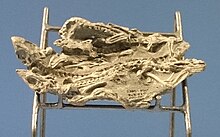Youngina (named after John Young (1823–1900)) is an extinct genus of diapsid reptile from the Late Permian Beaufort Group (Tropidostoma-Dicynodon zones) of the Karoo Red Beds of South Africa.[1] This, and a few related forms, make up the family Younginidae, within the order Eosuchia (proposed by Broom in 1914). Eosuchia, having become a wastebasket taxon for many probably distantly-related primitive diapsid reptiles ranging from the Late Carboniferous to the Eocene, Romer proposed that it be replaced by Younginiformes (that included Younginidae and the Tangasauridae, ranging from the Permian to the Triassic).
| Youngina Temporal range: Late Permian,
| |
|---|---|

| |
| Juveniles | |
| Scientific classification | |
| Domain: | Eukaryota |
| Kingdom: | Animalia |
| Phylum: | Chordata |
| Class: | Reptilia |
| Clade: | Diapsida |
| Clade: | Neodiapsida |
| Family: | †Younginidae |
| Genus: | †Youngina Broom 1914 |
| Type species | |
| †Youngina capensis | |
Taxonomy
editYoungina is known from several specimens. Many of these were attributed to as separate genera and species (such as Youngoides and Youngopsis), but it was later realized that they were not distinct from Y. capensis.[2][3] The holotype specimen of Youngina, discovered by Broom himself,[2] was described briefly in 1914.[4] The "Youngoides romeri" specimen was first attributed to Youngina,[5] but later given its eponymous and separate designation in a later paper.[6] Acanthotoposaurus[7] is also a junior synonym of Youngina.[8]
Description
editYoungina was a relatively small reptile, with a skull length of 5 centimetres (2.0 in) and a total body length of 30 centimetres (12 in).[9] The braincase anatomy was redescribed in 2010.[10] Youngina shows a mosaic of features found in more primitive diapsids and more derived taxa such as archosauromorphs and lepidosauromorphs suggesting a non-orthogenetic evolution of these characters. Though the palatobasal articulation is open,[10] it was probably immobile, similar to the skull of the tuatara,[11] contrary to some earlier claims made about the metakinetic mobility of basicranial joints in Youngina and other early diapsid reptiles.[12]
Phylogeny
editYoungina was once thought to be closely related to Acerosodontosaurus, and more distantly to tangasaurids (Kenyasaurus, Hovasaurus, Thadeosaurus, and Tangasaurus), but the monophyly of younginiforms has not been demonstrated in published analyses of diapsid reptiles, and it is likely this group is paraphyletic. Acerosodontosaurus is probably closer to other former younginiforms, rather than being closely related to Youngina.[13] Below is a cladogram from the analysis of Reisz et al. (2011) showing the phylogenetic position of Youngina among early diapsids:[14]
References
edit- ^ Smith, R.; Evans, S. (1996). "New Material of Youngina: Evidence of Juvenile Aggregation in Permian Diapsid Reptiles" (PDF). Palaeontology. 39 (2): 289–303. Archived (PDF) from the original on 2019-07-30.
- ^ a b Gow, C. E. (1975). "The morphology and relationships of Youngina capensis Broom and Prolacerta broomi Parrington". Palaeontologia Africana. 18: 89–131. hdl:10539/16290.
- ^ Evans, S. E. (1987). "The braincase of Youngina capensis (Reptilia: Diapsida; Permian)". Neues Jahrb. Geol. Paläontol. Monats. 1987: 193–203.
- ^ Broom, R. (1914). "A new thecodont reptile". Proceedings of the Zoological Society of London. B. 84 (4): 1072–1077. doi:10.1111/j.1469-7998.1914.tb07729.x.
- ^ Olson, E. C. (1936). "Notes on the Skull of Youngina Capensis Broom". Journal of Geology. 44 (4): 523–533. Bibcode:1936JG.....44..523O. doi:10.1086/624447. JSTOR 30068180. S2CID 140142731.
- ^ Olson, E. C.; Broom, R. (1937). "New genera and species of tetrapods form the Karroo beds of South Africa". Journal of Paleontology. 11 (7): 613–619. JSTOR 1298390.
- ^ Evans, S. E.; Van der Heever, J. A. (1987). "A new reptile (Reptilia: Diapsida) from the Upper Permian Daptocephalus zone of South Africa". South African Journal of Science. 83 (11): 724–730.
- ^ Reisz, R. R.; Modesto, S. P.; Scott, D. (2000). "Acanthotoposaurus bremneri and the origin of the Triassic archosauromorphreptile fauna of South Africa". South African Journal of Science. 96 (8): 443–445.
- ^ Hunt, Annabel K.; Ford, David P.; Fernandez, Vincent; Choiniere, Jonah N.; Benson, Roger B. J. (September 2023). "A description of the palate and mandible of Youngina capensis (Sauropsida, Diapsida) based on synchrotron tomography, and the phylogenetic implications". Papers in Palaeontology. 9 (5). doi:10.1002/spp2.1521. ISSN 2056-2799.
- ^ a b Gardner, Nicholas M.; Holliday, Casey M.; O'Keefe, F. Robin (2010). "The Braincase of Youngina capensis (Reptilia, Diapsida): New Insights from High-Resolution CT Scanning of the Holotype". Palaeontologia Electronica. 13 (3): 19A.
- ^ Johnston, P. (2010). "The constrictor dorsalis musculature and basipterygoid articulation in Sphenodon". Journal of Morphology. 271 (3): 280–292. doi:10.1002/jmor.10797. PMID 19806656. S2CID 32965233.
- ^ Evans, S. E. (1980). "The skull of a new eosuchian reptile from the Lower Jurassic of South Wales". Zoological Journal of the Linnean Society. 70 (3): 203–264. doi:10.1111/j.1096-3642.1980.tb00852.x.
- ^ Bickelmann; Müller; Reisz (2009). "The enigmatic diapsid Acerosodontosaurus piveteaui (Reptilia: Neodiapsida) from the Upper Permian of Madagascar and the paraphyly of "younginiform" reptiles". Canadian Journal of Earth Sciences. 46 (9): 651–661. Bibcode:2009CaJES..46..651S. doi:10.1139/E09-038.
- ^ Reisz, Robert R.; Modesto, Sean P.; Scott, Diane M. (2011). "A new Early Permian reptile and its significance in early diapsid evolution". Proceedings of the Royal Society B. 278 (1725): 3731–3737. doi:10.1098/rspb.2011.0439. PMC 3203498. PMID 21525061.
External links
edit- "Youngina". Paleobiology Database. Retrieved 2024-02-28.